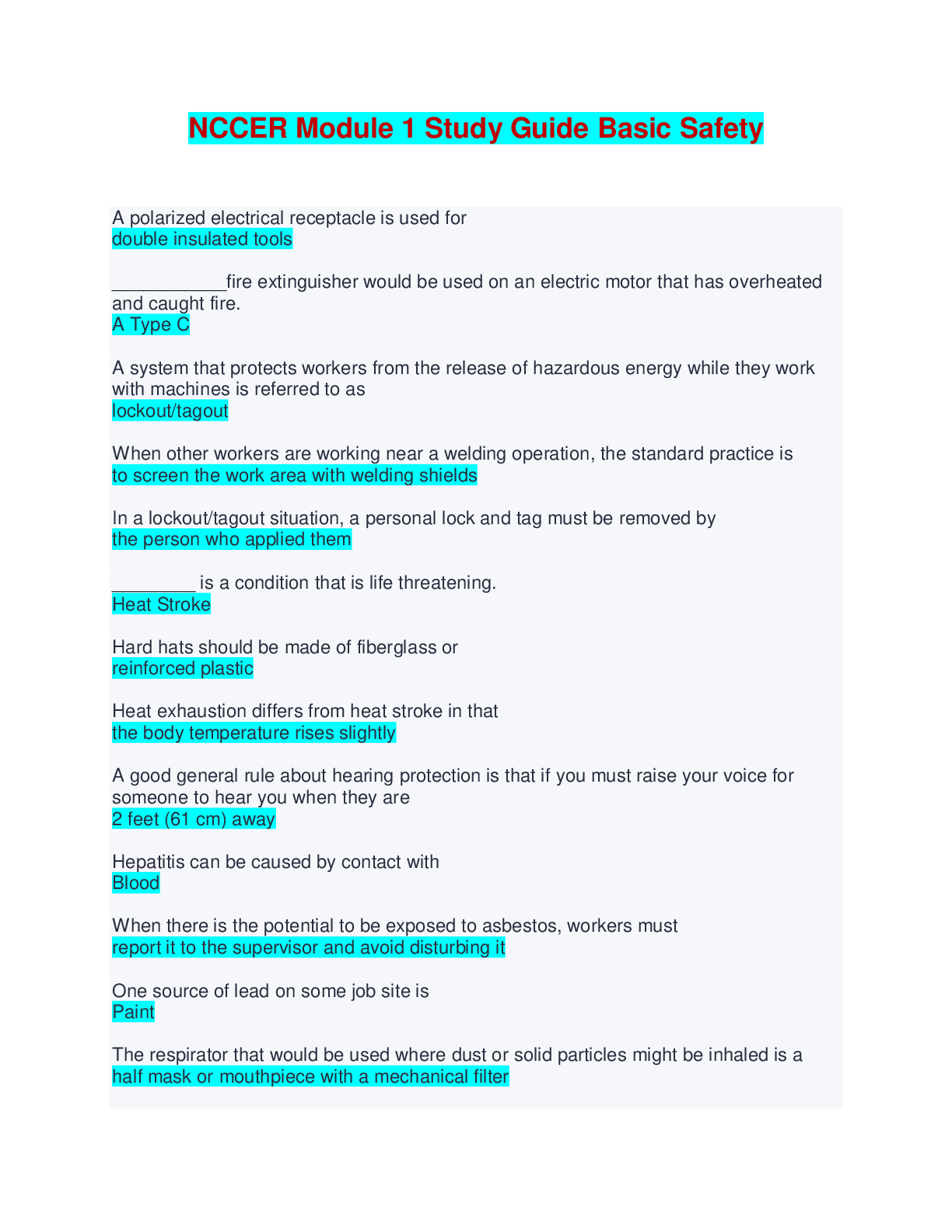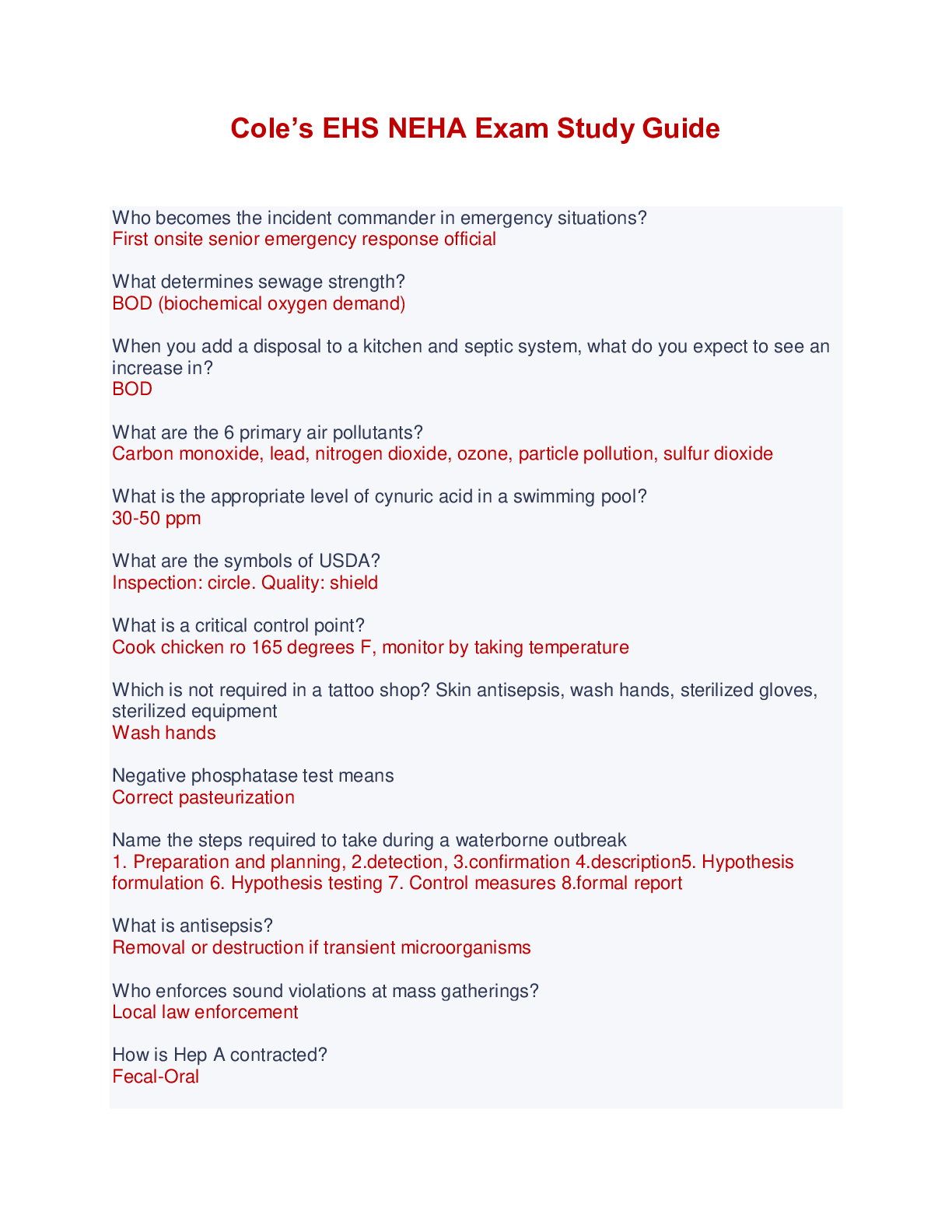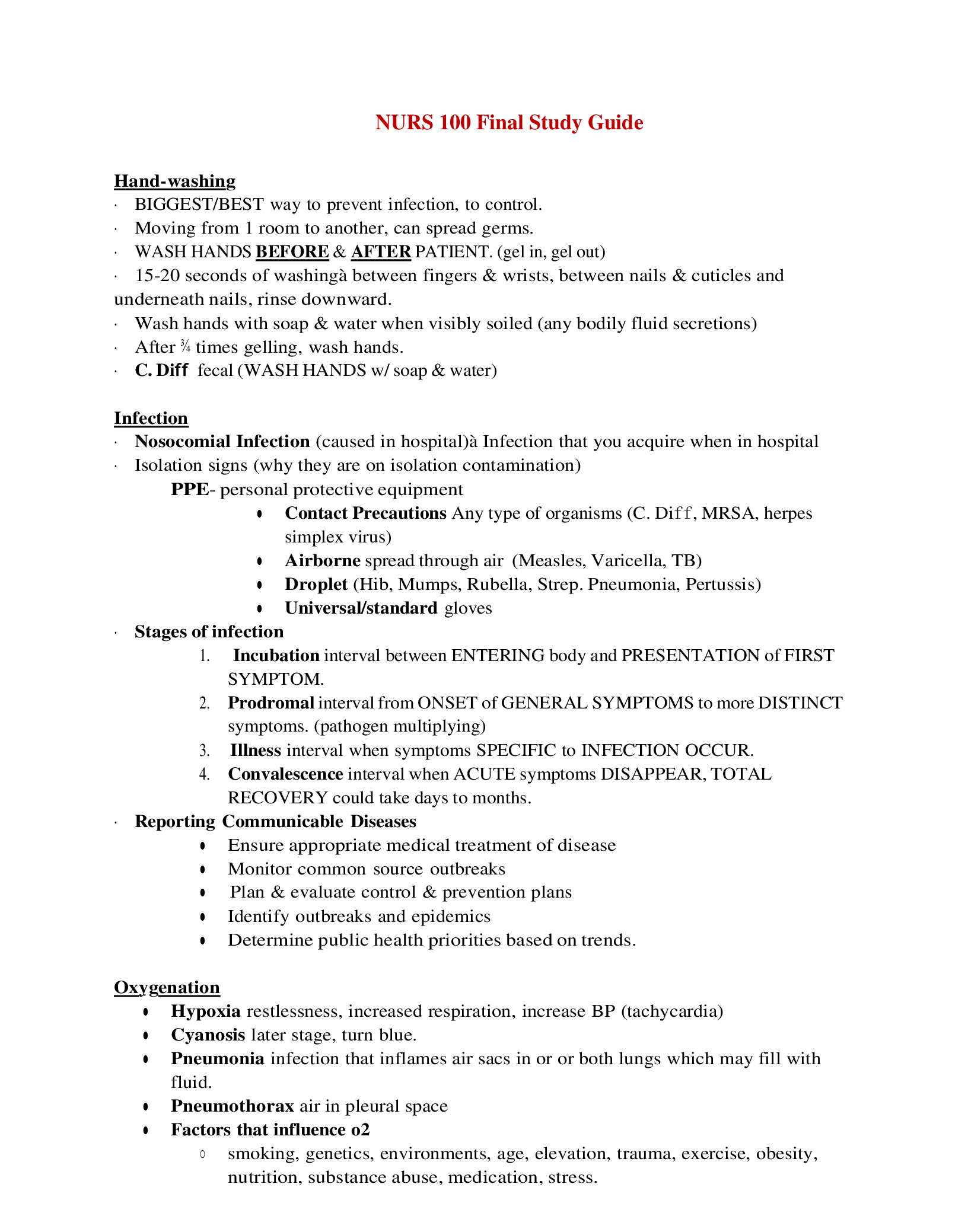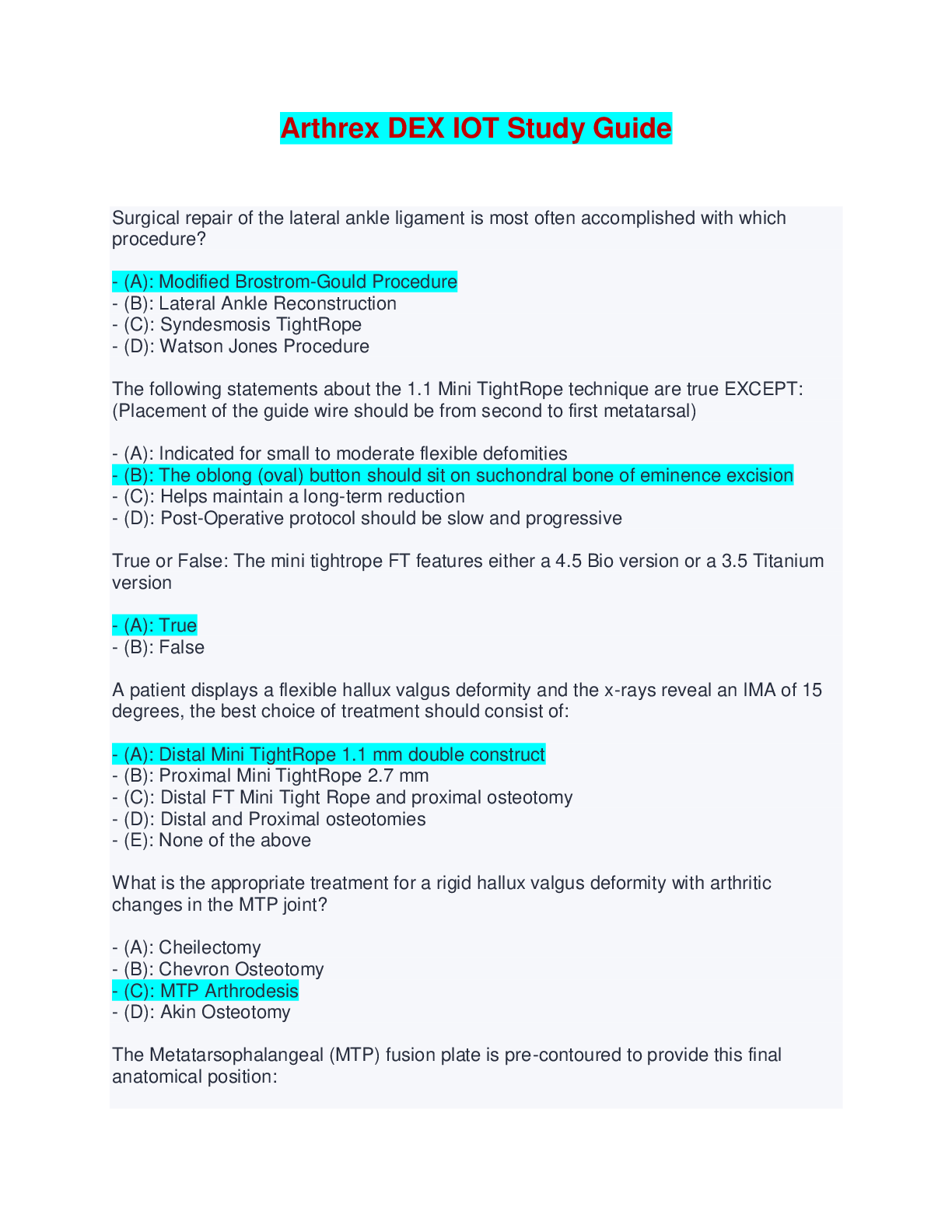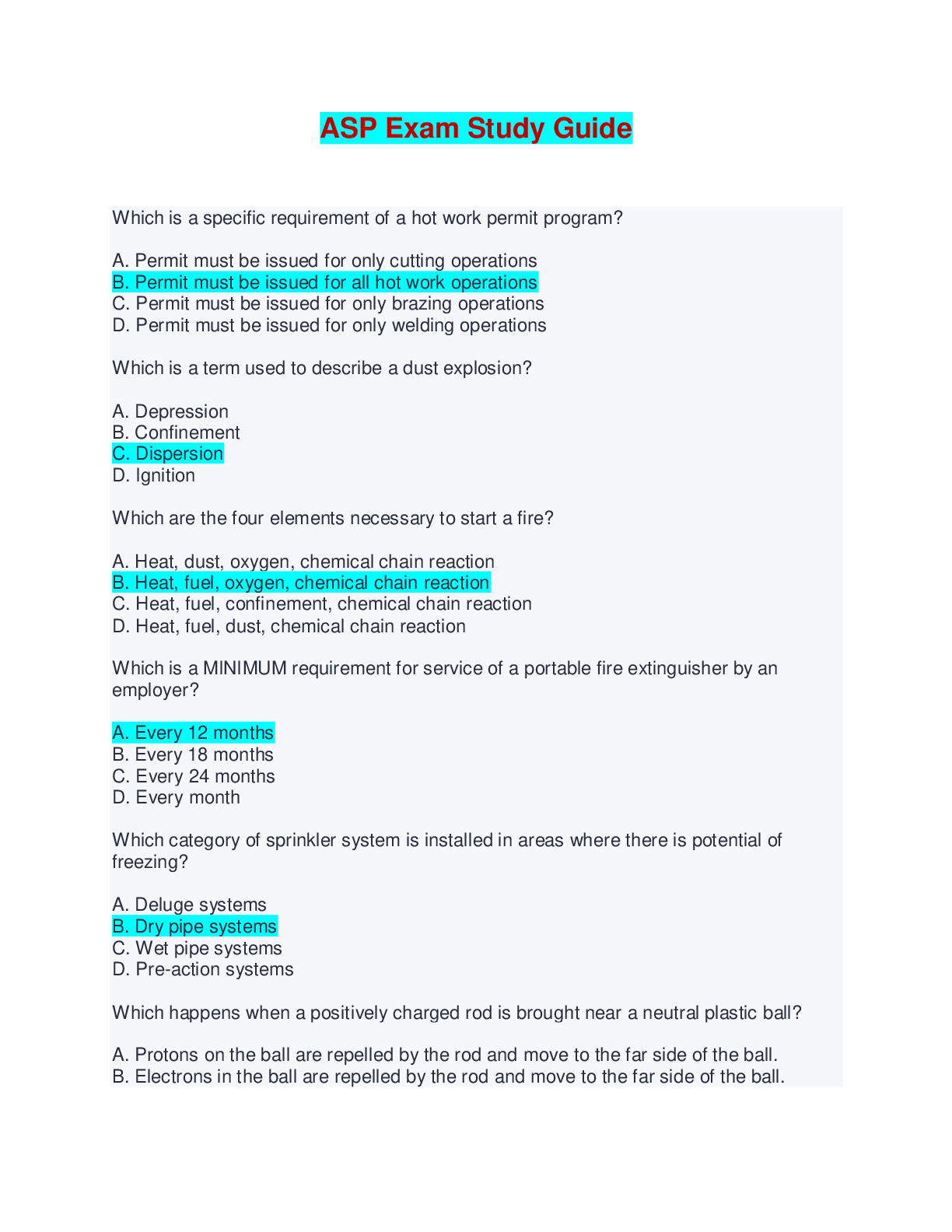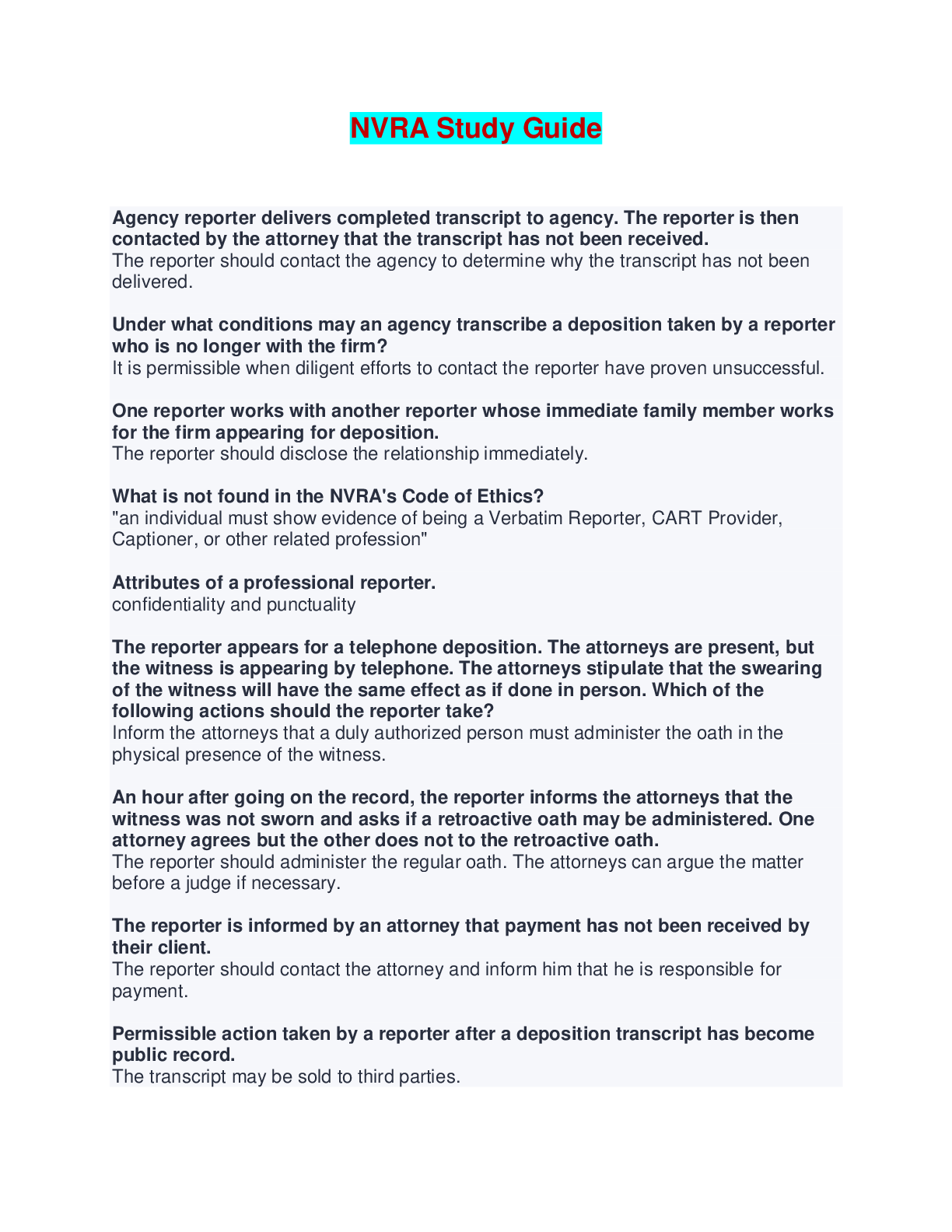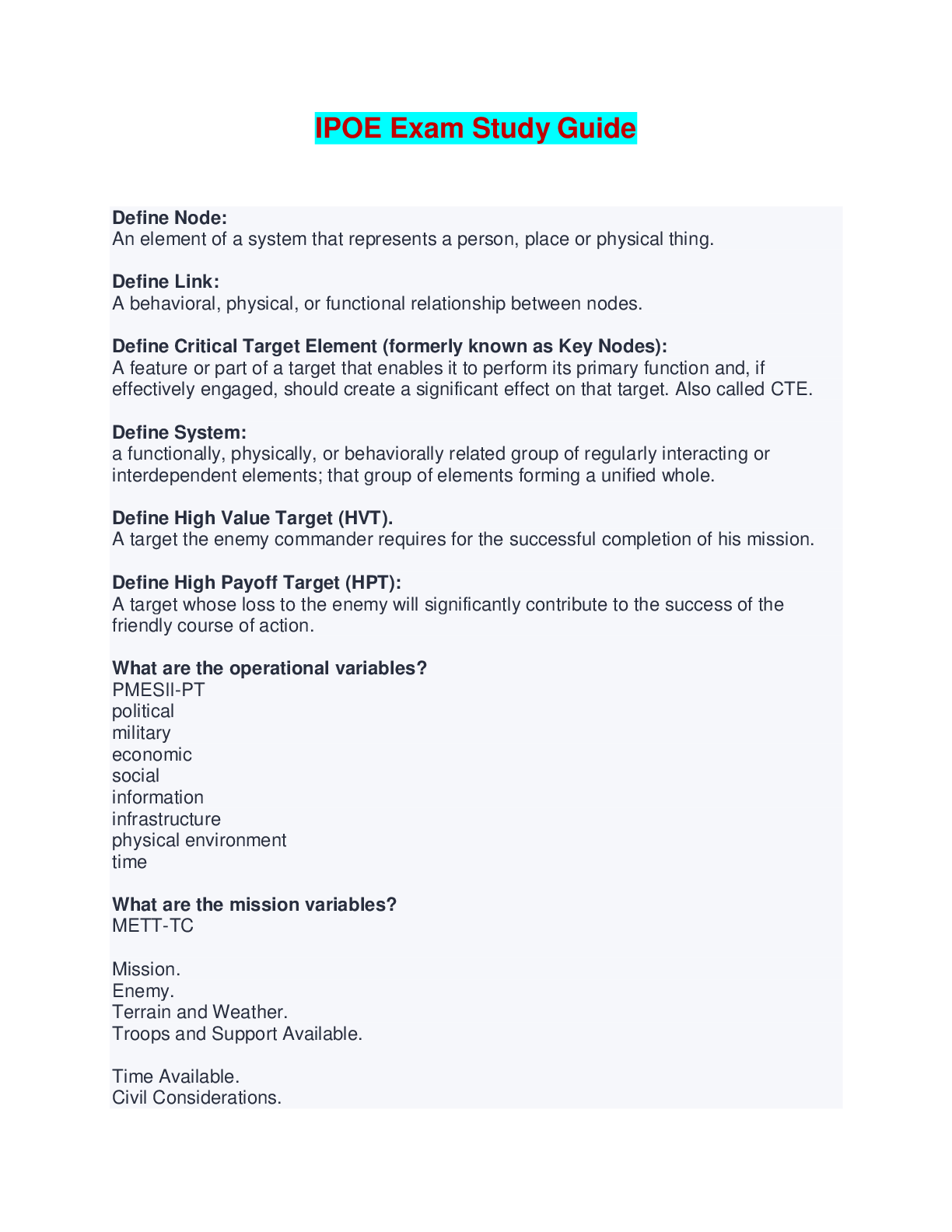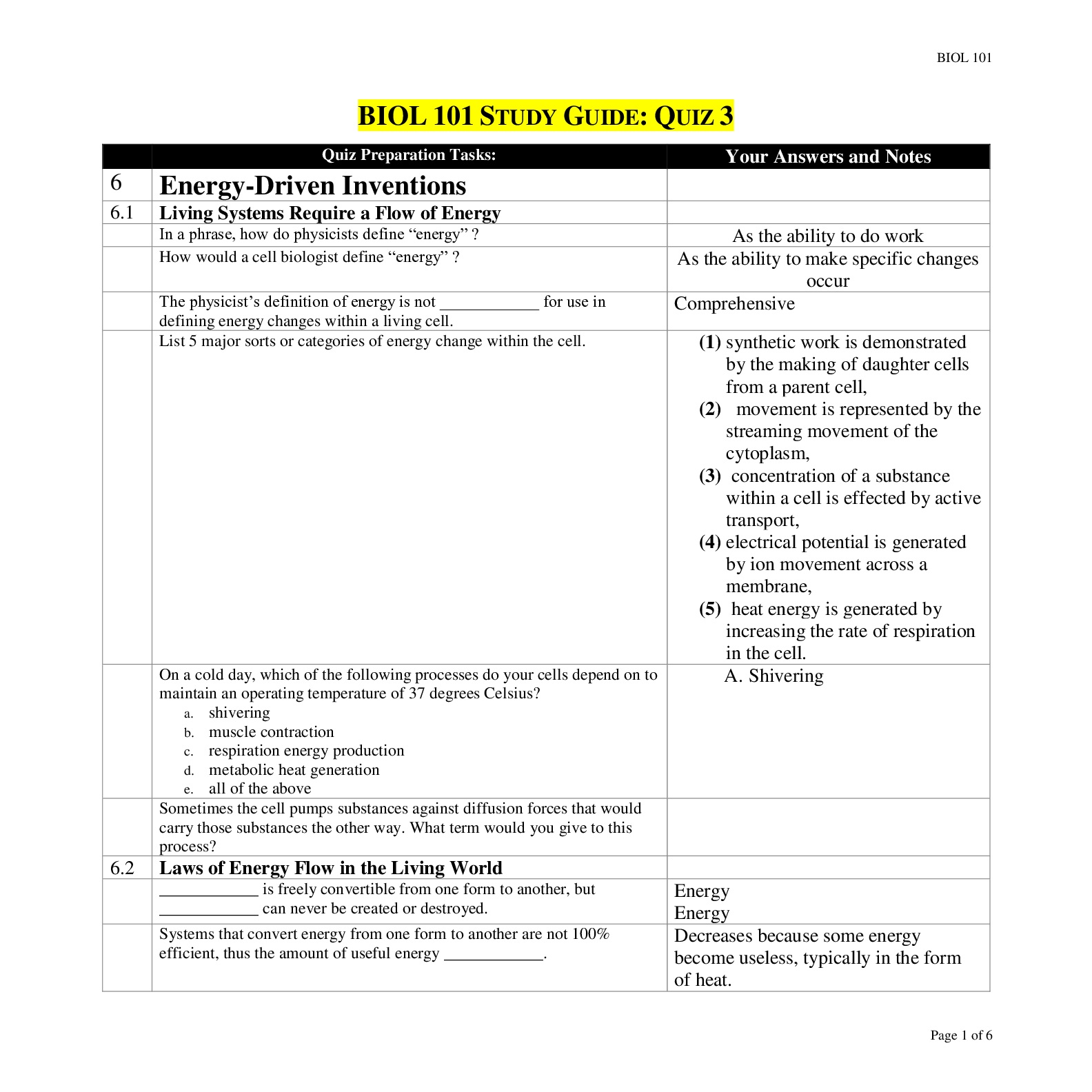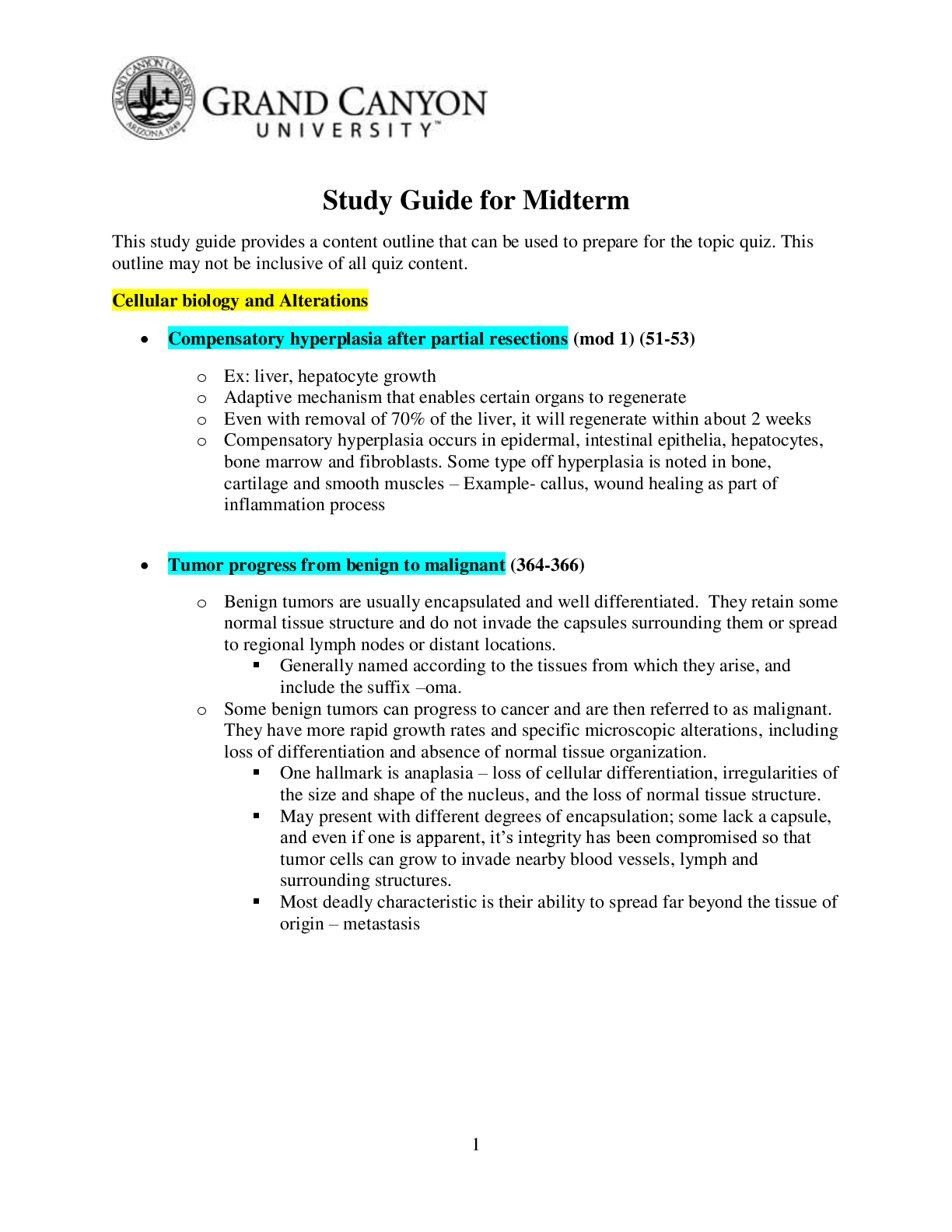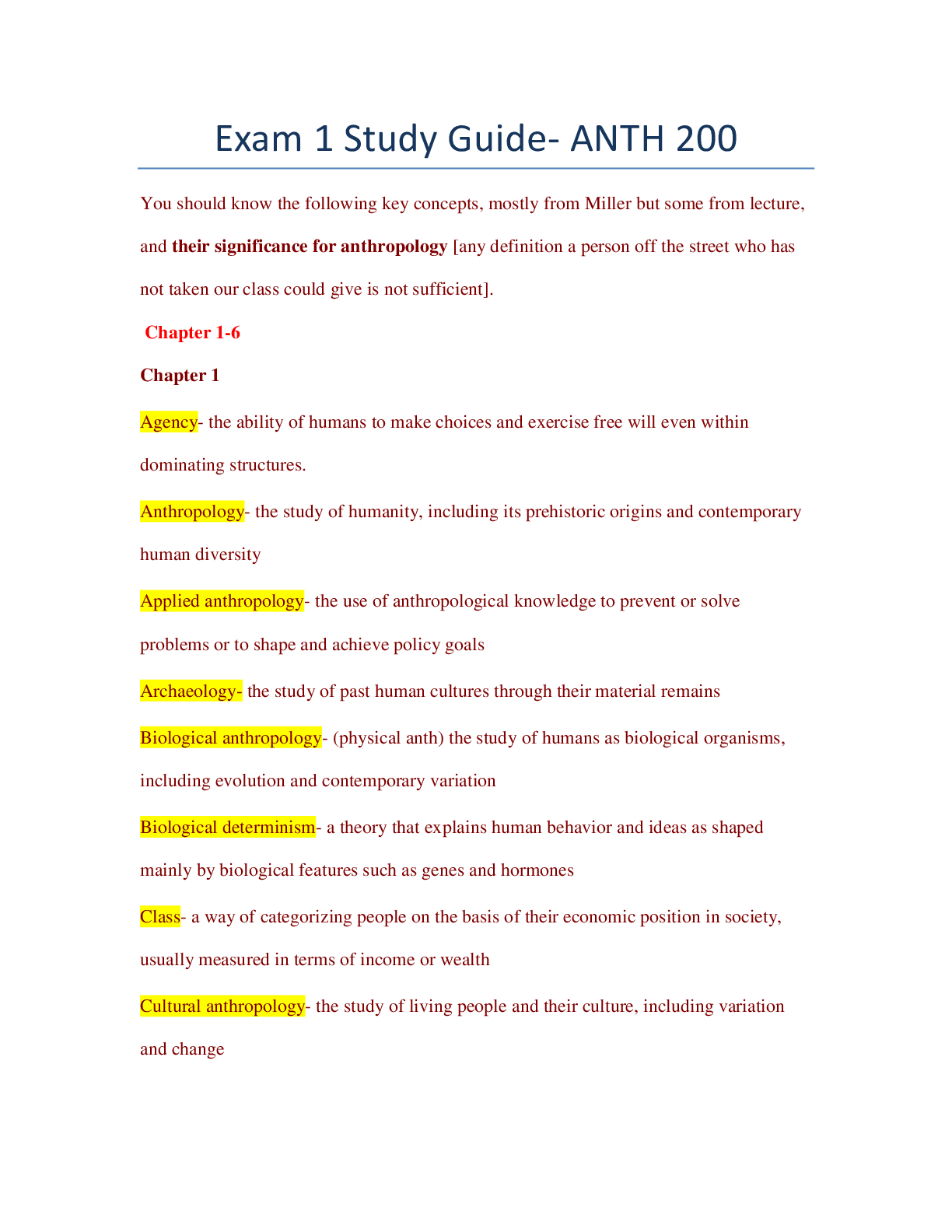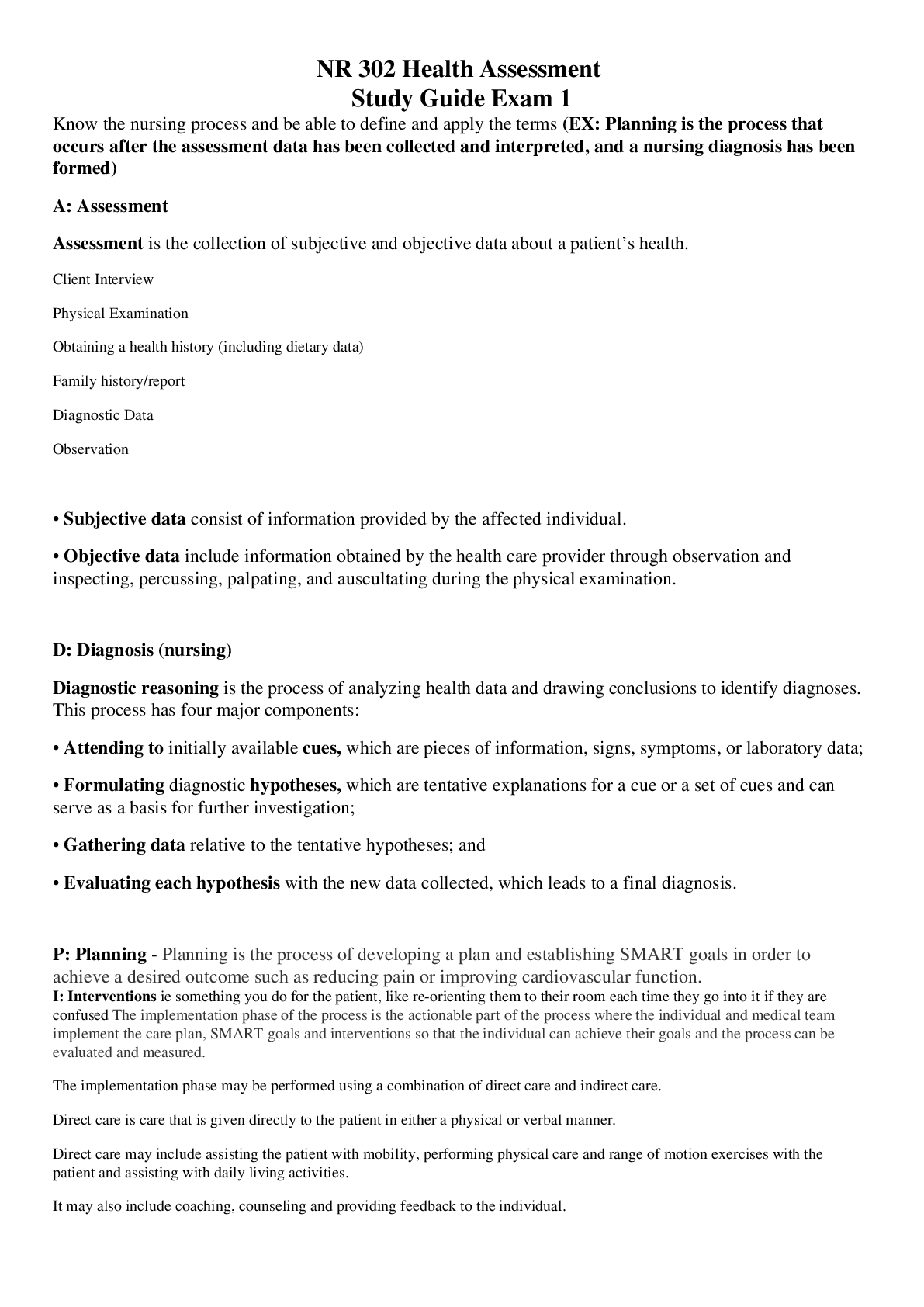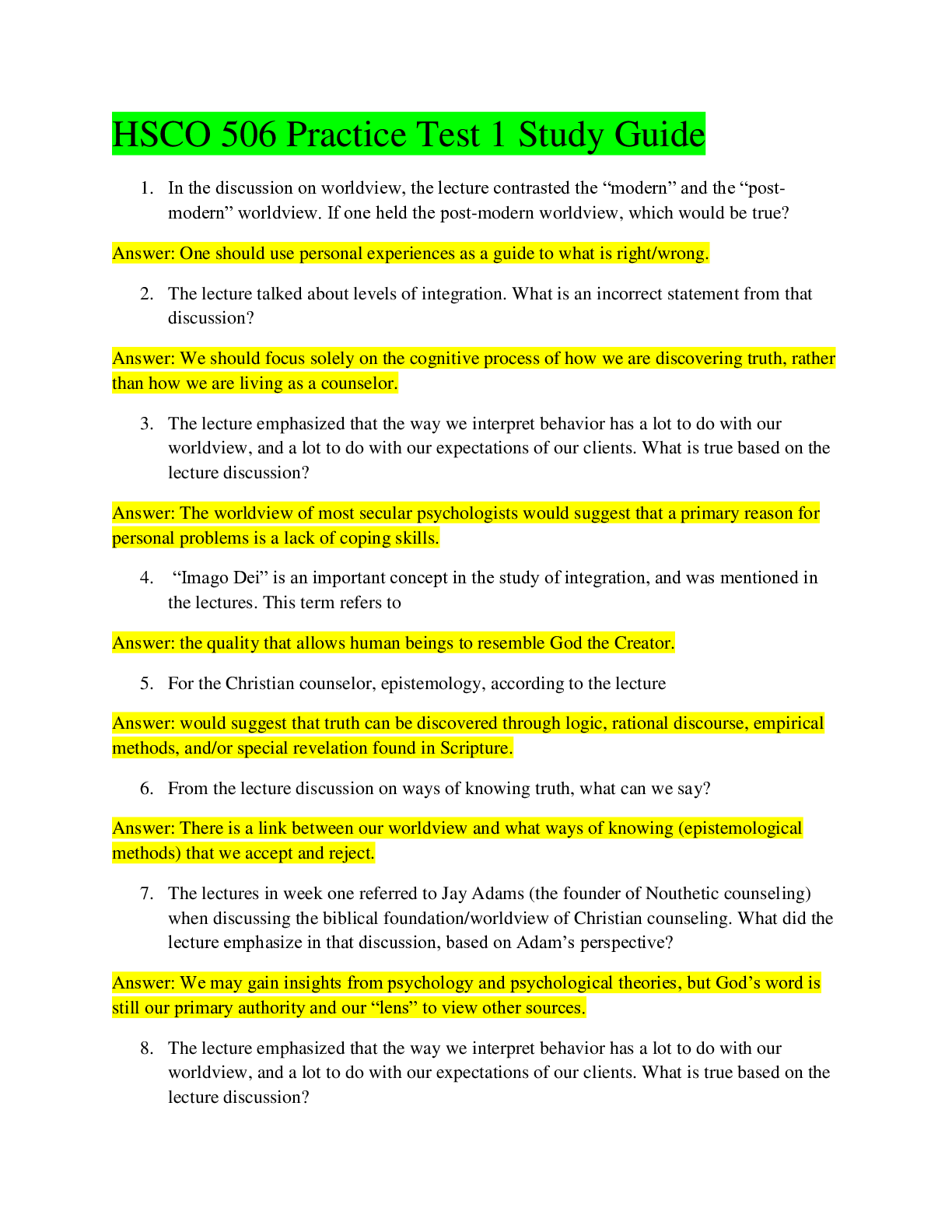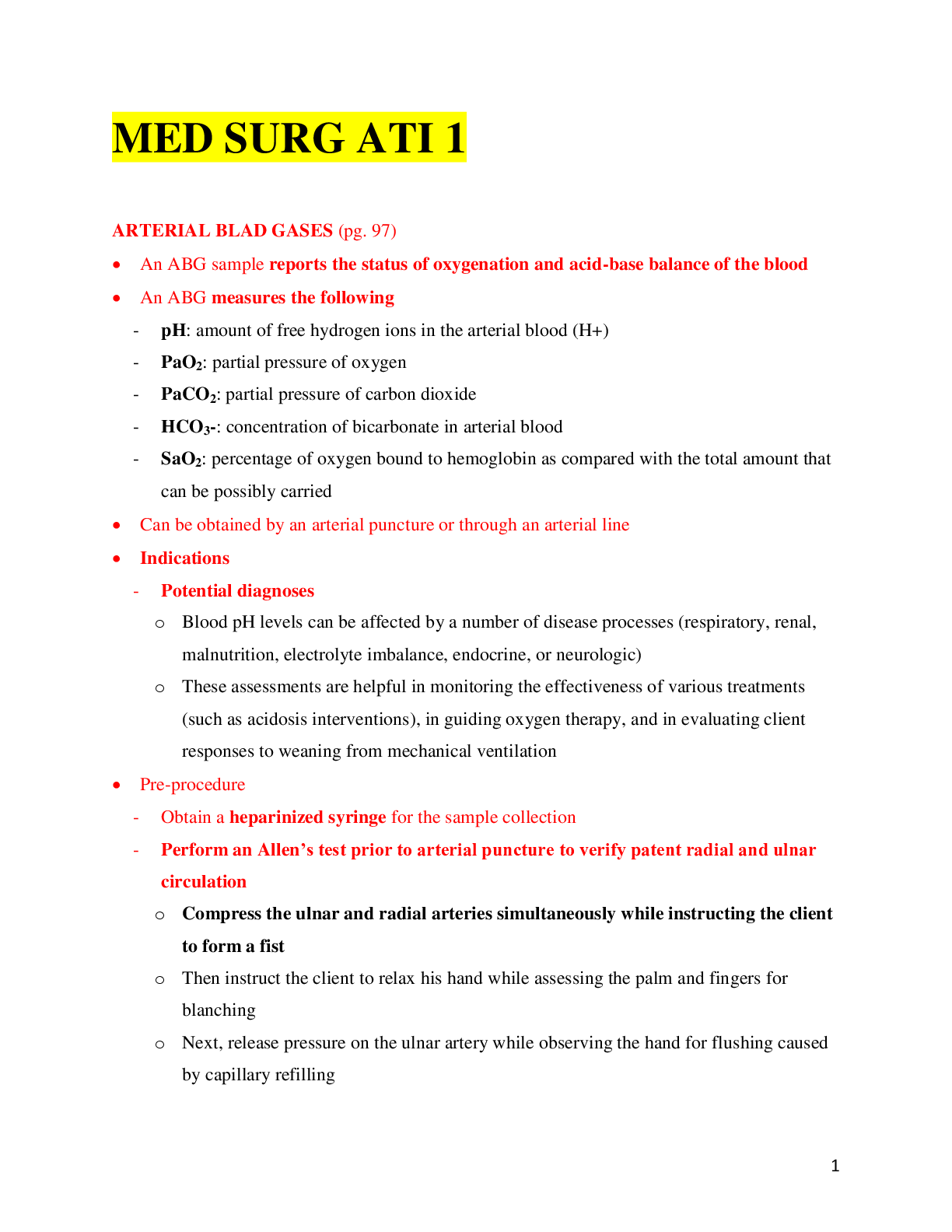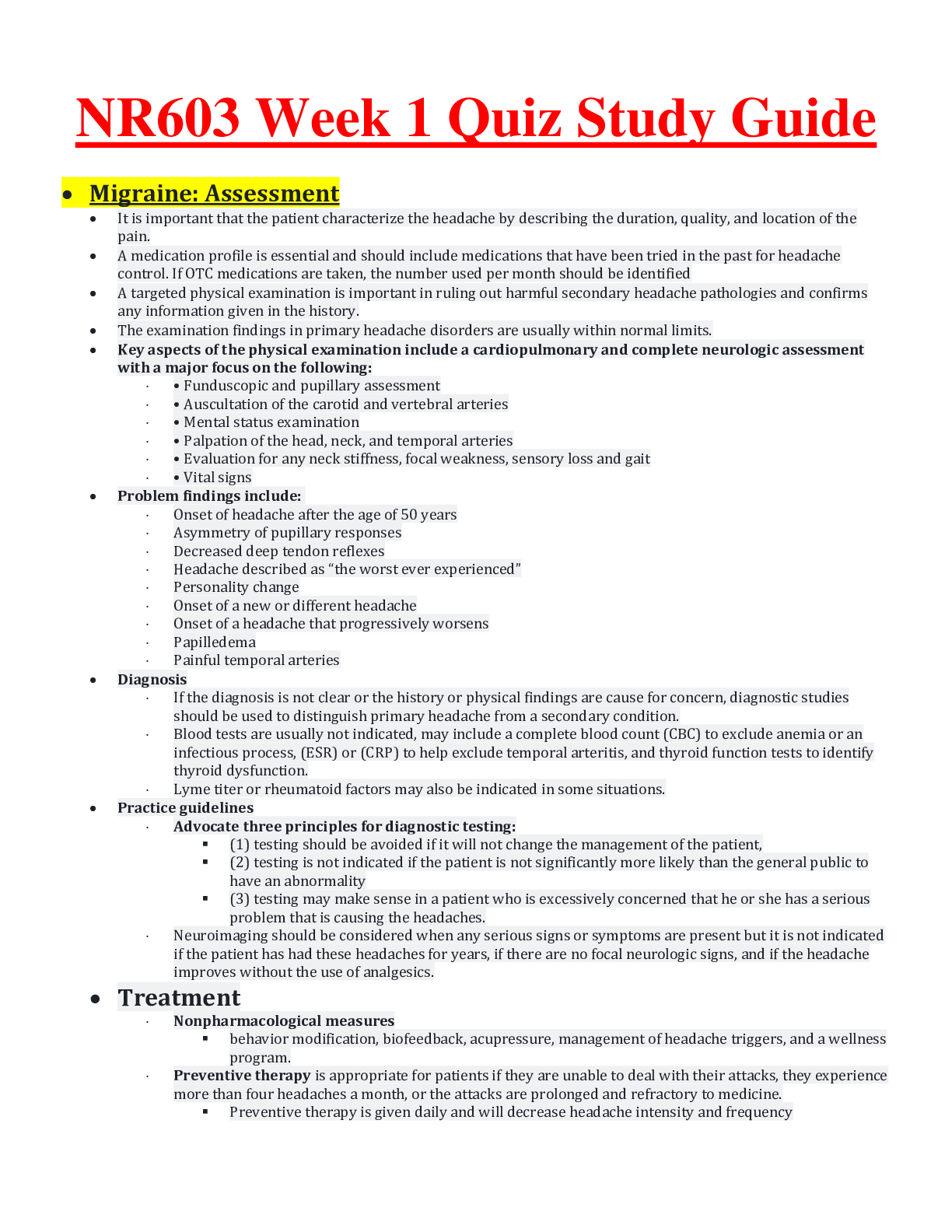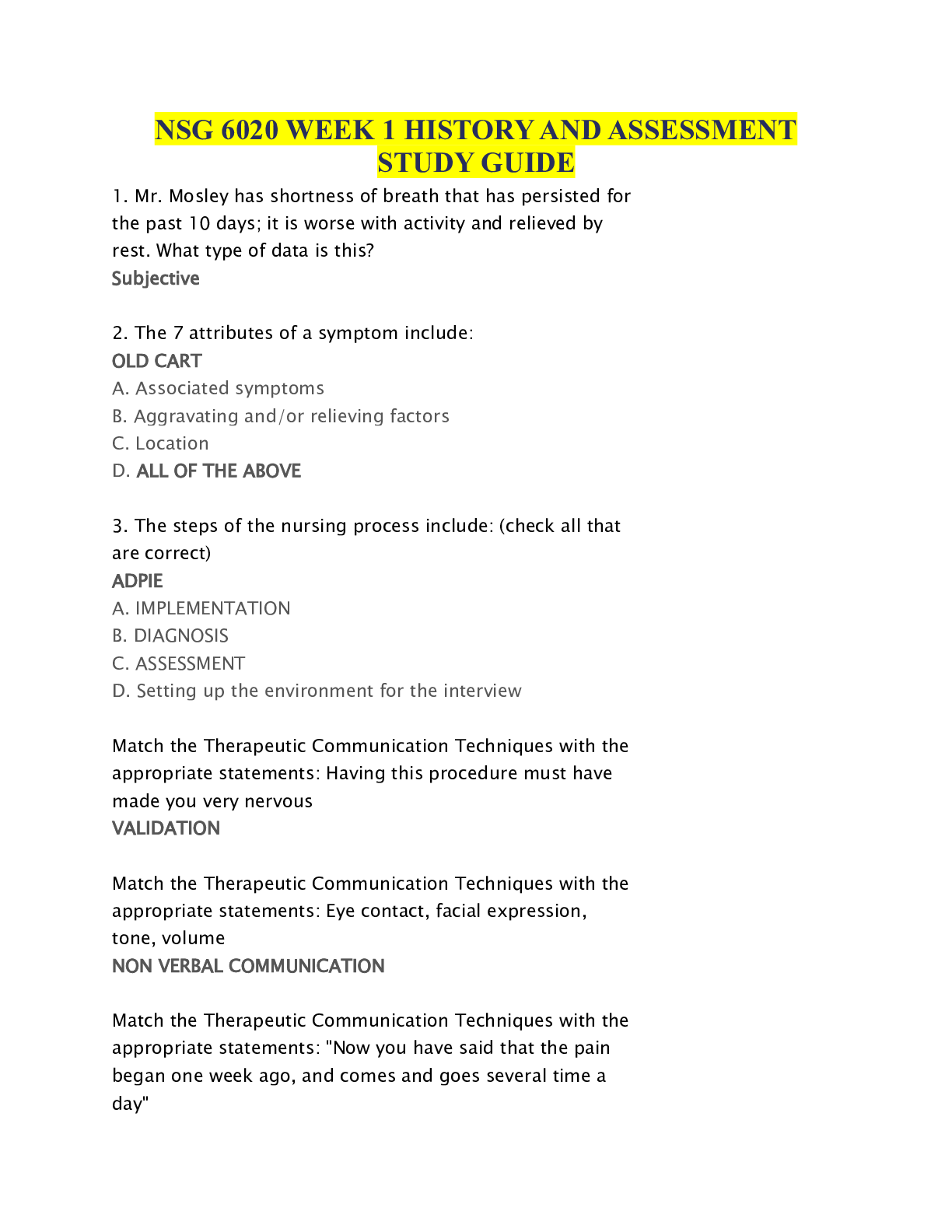*NURSING > STUDY GUIDE > NURS 100 Nursing Fundamentals | NURS 100 Quiz 1 Study Guide (All)
NURS 100 Nursing Fundamentals | NURS 100 Quiz 1 Study Guide
Document Content and Description Below
NURS 100 Nursing Fundamentals | NURS 100 Quiz 1 Study Guide 1. Communication is the means to establish helping-trust relationships. 2. Need to find 3. Nursing diagnosis is Impaired Verbal Communicati... on and could be due to: 1. Inability to articulate words 2. Inappropriate verbalization 3. Difficulty forming words 4. Difficulty comprehending 4. If patients cannot speak clearly use letter board, flash cards etc, a. If Cognitive impairment: use family and friends in conversations also use pictures or gestures b. Patients who are hearing impaired: reduce environmental noise, face patients with mouth visible, use sign-language interpreter if indicated. c. Visually impaired Use 14 point font +, Identify yourself when you enter room and when you leave. d. If they don’t speak English use communication board, pictures, cards, interpreter. 5. Aspects of Professional Communication are: a. Appearance, Courtesy, Use of Names, Autonomy and responsibility, Assertiveness, Trustworthiness. 6. The qualities, behaviors and communication techniques that affect professional communication are a. Active listening, Therapeutic communication, SOLER, Sharing Observations, b. Sharing empath, hope, humor, feelings. c. Using silence, providing info, clarifying, paraphrasing, validation, asking relevant questions. d. Therapeutic Communication Techniques: are specific responses that encourage the expression of feelings and ideas and convey acceptance and respect. e. Active listening: being attentive to what a patient is saying both verbally and nonverbally. i. Use SOLER acronym 1. S: sit facing the patient 2. O: open position (arms and legs uncrossed) 3. L: Lean toward a patient 4. E: Eye contact, 5. R: Relax ii. Sharing Observations: commenting on how the person looks, sounds or acts. ( someone who didn’t eat their food “ I see you haven’t eaten anything”) iii. Sharing Empathy: being able to be empathic with patients (ability to understand and accept another person’s reality, accurately perceive feelings and communicate this understanding to the patient) iv. Sharing Hope: hope is an essential part of healing. v. Sharing Humor: helps relieve stress, tension, anxiety and worry. It also increases interpersonal communication by making the nurse seem more caring, warm and approachable. vi. Sharing Feelings: it is okay to share feeling with patients and increased the interpersonal communication. However, do not allow the emotions to become uncontrolled or cause the patient distress/ break confidentiality. 1. Avoid expressing anger/sadness. vii. Using Touch: can convey affection, emotional support, encouragement, tenderness, and personal attention. 1. It is important to know when touch is appropriate and you should always ask before you touch. viii. Using Silence: If silence is initiated let the patient break the silence this gives you time to think ix. Clarifying: it is always important to clarify an ambiguous statement made by a patient. x. Focusing: this is a way to redirect the conversation to more effective topics xi. Validation: You want to let the patient know that you have heard their concerns, feelings, and thoughts. 1. “Tell me if I understand you are worried about…..” xii. Asking Relevant Questions: These questions are needed to allow a nurse to make a decision about a patient 1. Try to avoid asking to many questions as it is dehumanizing. xiii. Summarizing: reviews the key aspects of a conversation and reminds patients of what was spoken about before. xiv. Self Disclosure: Try to find common ground with a patient sympathize with them. xv. Confrontation: is when you help someone understand they are being inconsistence with their feelings, attitudes, beliefs and behaviors. Territoriality and Personal Space: is the need to maintain and defend ones right to space. xvi. When personal space becomes threatened people respond defensively and communicate less effectively. f. Zones of personal Space i. Intimate Zone is 0-8’ 1. Holding a crying infant 2. Performing physical assessment 3. Bathing, grooming, dressing, feeding, and toileting a patient 4. Changing a patients surgical dressing ii. Personal zone is 18inches to 4ft 1. Sitting at a patient’s bedside 2. Taking a patient’s nursing history 3. Teaching an individual patient iii. Socio-Consultative Zone 9 to 12 feet 1. Giving directions to visitors 2. Asking if families need assistance from the patient door way 3. Giving a verbal report to a group of nurses iv. Public zone 12+ feet 1. Speaking at a community forum 2. Lecturing a class of students 3. Testifying at a legislative hearing g. Special zones of touch i. Social zone (permission not needed) 1. Hands, arms, shoulders, back ii. Consent zone (Permission needed) 1. Mouth, wrists, feet iii. Vulnerable Zone 1. Face, neck, front of body iv. Intimate zone 1. Genitalia, rectum Vital Signs 1. Normal Vital Signs: i. Temp: 36-38C (98.6-100.4F) ii. Oral: 37C/98.6F iii. Rectal 37.5C/99.5F iv. Axillary 36.5C/97.7F b. Pulse 60-100BPM, Strong/regular c. Oximetry 95%+ d. Respirations Adult: 12-20 Breaths/min e. BP: 120/80, Pulse pressure 30-50mm hg (difference between systolic/diastolic) f. CO2 35-45mm hg 2. Factors that cause changes in Vital signs a. Age (infants 95.9-99.5) older adults 95-97 b. Exercise increases body temp c. Hormone levels (women fluctuate more than men) d. Circadian Rhythm (Lowest between 1-4am) e. Environment f. Stress g. Temperature Alterations 3. Ranges for Infant, Child, Adult a. HR: Infant 120-160, Child 75-100, Adult 60-100 b. Respiratory Rate: Infant 30-50, Child 20-30, Adult 12-20 c. BP: infant 65-115/42-80 mm Hg, Child 87-117/48-64 mm Hg, Adult 120/80 4. When to take vital signs a. On admission b. When assessing patient during home care visit c. In hospital on their schedule, before, during, after surgery or, i. Transfusion of blood ii. Administration of meds iii. Nursing intervention d. When patient general condition changes e. When patient reports not specific symptoms 5. NEED TO FIND Infection Control 1. Chain of infection and disruption. a. An infectious agent or pathogen, (WASH HANDS can use antibacterial/fungal, bactericidal agents) b. A reservoir or source for pathogen growth (can use pesticides and bactericidal agent) c. Port of exit (use standard, contact and droplet) precautions to prevent spread. d. Mode of Transmission (Wash hands, and equipment to prevent transmission) e. Portal of entry ( need to cover lesions, cuts, scrapes, eyes, mucous membranes to avoid getting HEP B) f. Susceptible host (Isolate host and ensure proper PPE and hand hygiene is completed) 2. Normal Body defenses against infection a. Normal flora located on skin prevent growth of other bacteria b. Mucous membranes are moist and have cilia to remove bacteria c. Inflammation (vasodilation, increased WBC to site{neutrophils and monocytes) i. Leukocytosis 3. Patients most at risk for infection are; a. Immunocompromised b. Older adults c. Chronic diseases (COPD, Heart Failure, diabetes) d. Nutritional Status e. Stress f. Disease process (ppl with aids, leukemia, aplastic anemia) 4. Conditions that promote the transmission of HAI are: a. Urinary Tract i. Unsterile insertion of urinary catheter ii. Improper positioning of the drainage tubing iii. Open drainage system iv. Improper perineal hygiene v. Improper specimen collection technique b. Surgical/Traumatic Wounds i. Improper skin preparation before surgery ii. Failure to clean skin surface properly iii. Failure to use aseptic technique during operative procedures and dressing iv. Using contaminated antiseptic solutions c. Respiratory Tract i. Contaminated respiratory equipment ii. Failure to use aseptic technique while suctioning airway iii. Improper disposal of secretions d. Bloodstream i. Contamination of IV fluids by tubing ii. Insertion of drug additives to IV fluid iii. Improper care of needle insertion site. iv. Contaminated needles 5. Local vs Systemic Signs of Infection a. Localized: Patient usually experiences i. Pain, tenderness, warmth, redness at the wound site b. Systemic i. Increased body temp, HR, WBC count, pain in systems/regions away from original site 6. Medical vs Surgical Asepsis a. Medical Asepsis: Hand hygiene, barrier techniques, and routine environmental cleaning i. Includes procedures for reducing the # of organisms present and preventing the transfer of organisms b. Surgical asepsis: Prevents contamination of an open wound, serves to isolate the operative area from the unsterile environment and maintains a sterile field for surgery. i. Procedures used to eliminate all microoganisms including pathogens and spores from object or area. 7. Rational of standard precautions a. To prevent and control infection and its spread i. Provide patients and healthcare workers protection against infections.. 8. Infection and Control intervention differences Home VS hospital a. In a home setting you do not have access to all the tools that are available in the hospital b. FIND OUT MOER INFO 9. Isolation Procedures for Each Category a. Airborne i. infection isolation: Negative airflow that is filtered through a HEPA filter. ii. Must also wear a N95 respirator/mask b. Droplet i. Wearing a surgical mask when within 3 feet of patient, proper hand hygiene and face protection c. Contact i. Require gown and gloves and proper hand hygiene d. Protective environment i. Focuses on limited patient population ii. Requires positive airflow room and patient must wear mask when out of their rooms 10. The difference between occupational [Show More]
Last updated: 1 year ago
Preview 1 out of 10 pages
Instant download

Buy this document to get the full access instantly
Instant Download Access after purchase
Add to cartInstant download
Also available in bundle (1)

NURS 100 QUIZ 1, MIDTERM AND FINAL EXAM STUDY GUIDES BUNDLE - WEST COAST UNIVERSITY
NURS 100 QUIZ 1, MIDTERM AND FINAL EXAM STUDY GUIDES BUNDLE - WEST COAST UNIVERSITY
By Nurse Henny 1 year ago
$20
3
Reviews( 0 )
Document information
Connected school, study & course
About the document
Uploaded On
Apr 16, 2023
Number of pages
10
Written in
Additional information
This document has been written for:
Uploaded
Apr 16, 2023
Downloads
0
Views
48




